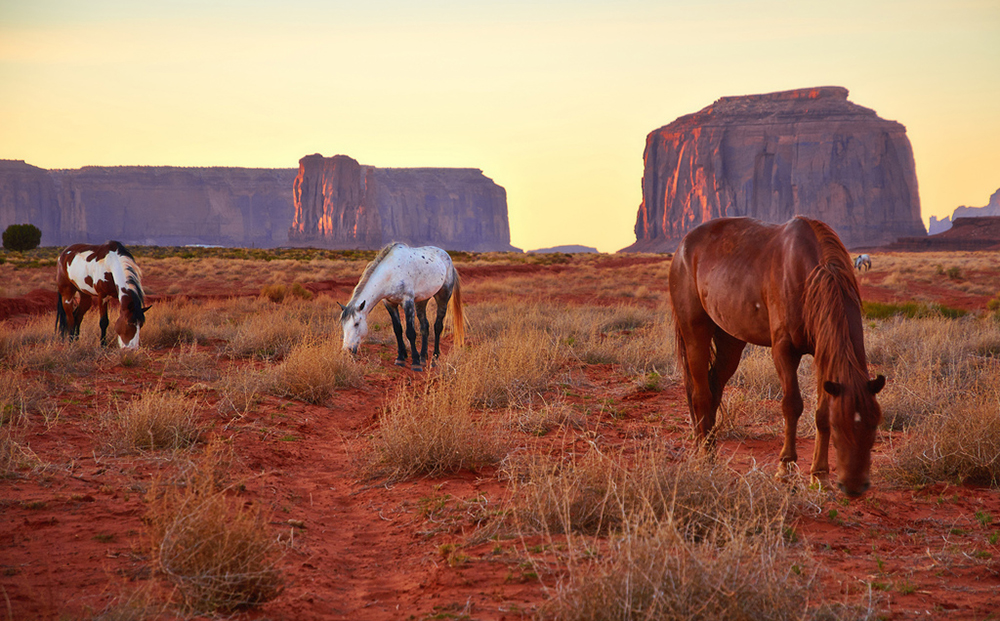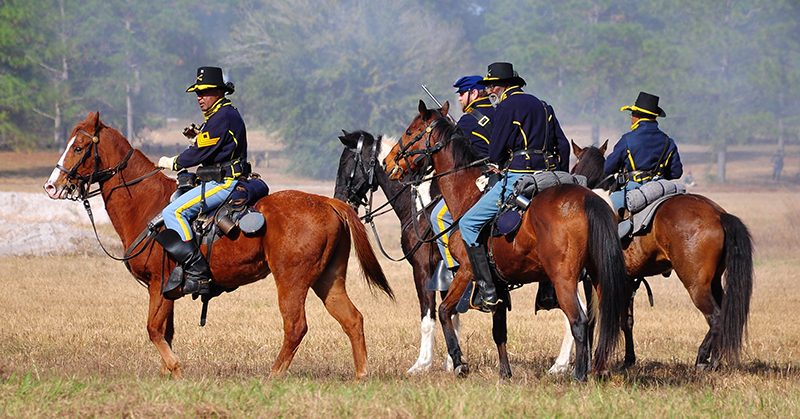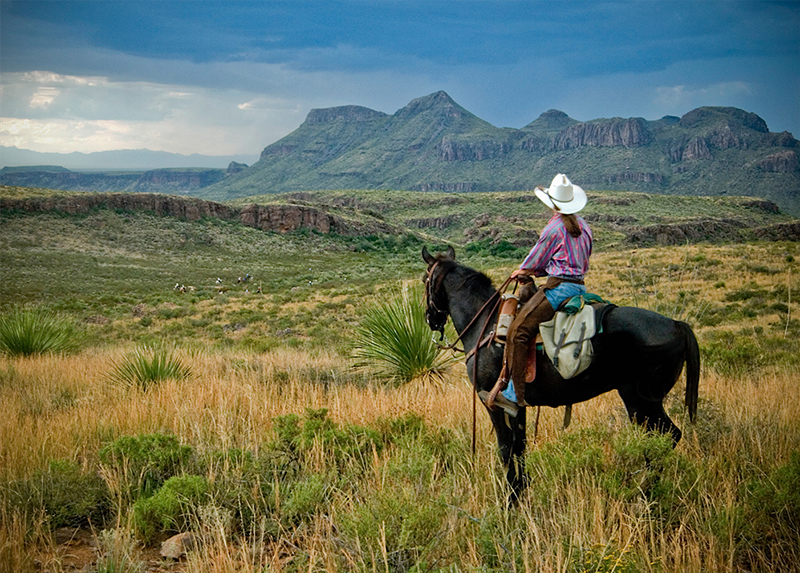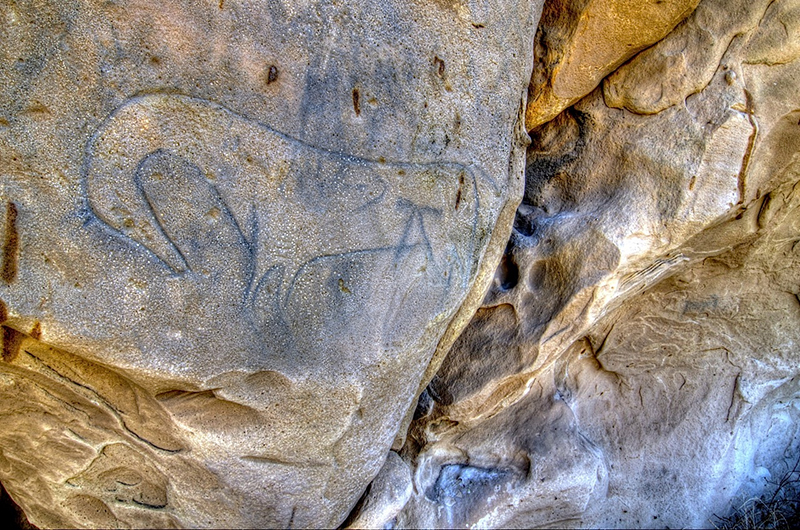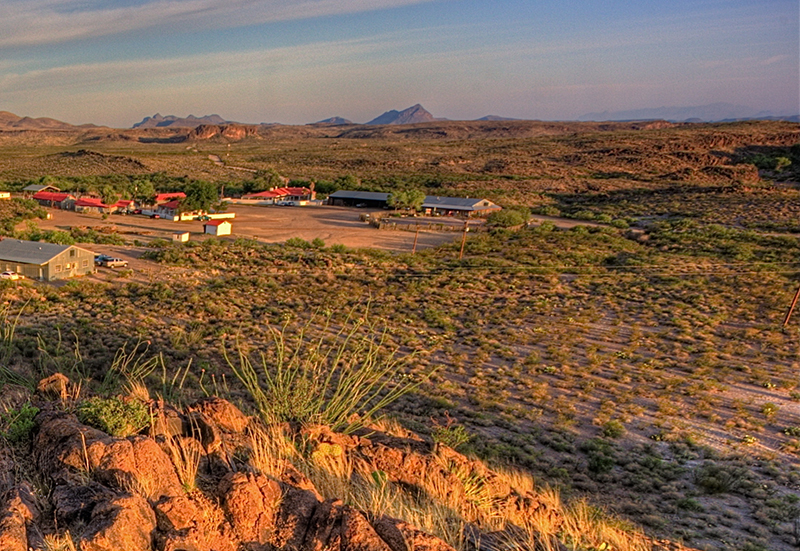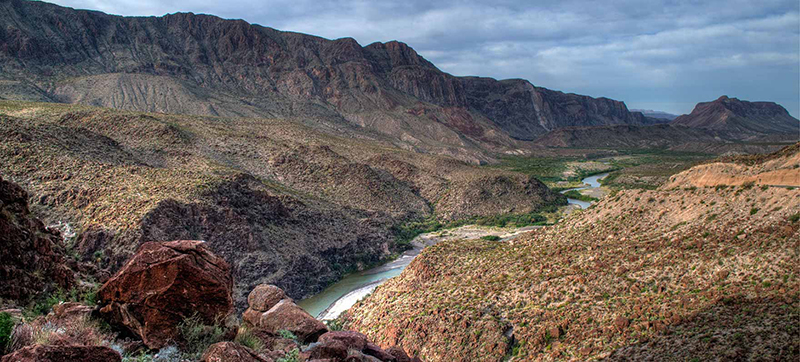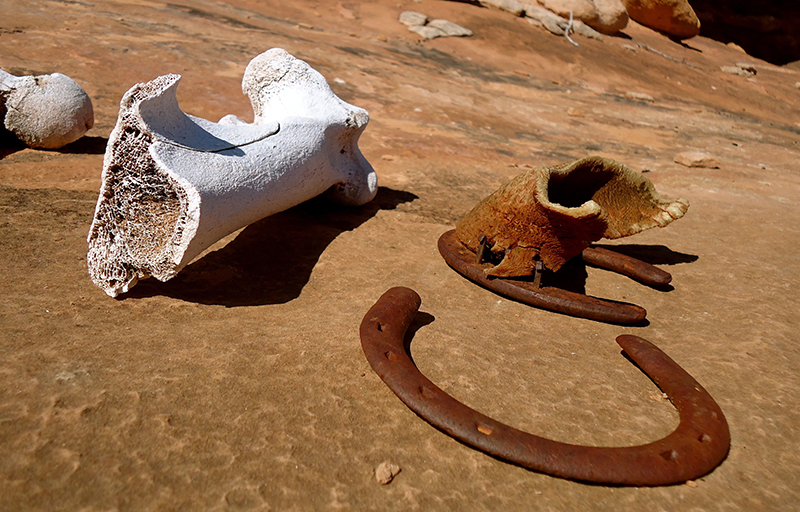I became a fool for horses rather late in life. In my early 30s I got a job as a counselor in a horseback program for juvenile delinquents. Except for a few pony rides as a kid — one at a circus and another offered by a classmate who had a crush on me — I had no experience with horses and learned along with my charges. The majority of the teenage girls with whom I worked were African-Americans, and the program honored the Buffalo Soldiers. (The Buffalo Soldiers — ninth and tenth Cavalry and 24th and 25th Infantry Regiments — were the first all-black units the U.S. military established and instrumental in campaigns against the Comanches and Apaches.) Together, we went through all the original drills, countless injuries and embarrassments, and about once a month, to a reenactment. Our battlefields were eastern, and the McClellan saddles and tack English-inspired, but our horses had been bred on desert and prairie soils: hardy Texas and Arizona ponies, some of them bearing white freeze brands on their necks that marked them as mustangs captured and auctioned off by the Bureau of Land Management.
My stint at this program still is the only time I ever set foot east of the Rockies. Our camp simmered in subtropical humidity near Florida’s Yeehaw Junction, a wretched crossroads 30 miles north of Lake Okeechobee. It was primitive: wall tents with cots for the kids, a mess tent, fenced pasture, and unfurnished trailers for staff, everything plunked into a clearing hacked from saw palmetto thickets — the unwanted rounded up in an unwanted place.
My first horse was Madman, and he was true to his name. A barrel-chested, short-legged sorrel gelding standing little over 14 hands and with a blaze like spilled cream running from his ears to his nostrils, he tended to chomp at the bit, quickly wearing himself out during our mock charges. Fellow galloping horses electrified him; he was not one to be left in anybody’s wake. Unfazed by fluttering standards or the flashing and waving of steel, by rebel yells or the booming of cannons, he was bombproof, stolid enough for me to run up from behind and jump into the saddle and take off at a canter. I could fire my replica Colt revolver next to his head without spooking him and ride into the thickest melee or double up with an unhorsed trooper. On the down side, he was foam-flecked and winded within half an hour if I did not check him. A bit hard-mouthed, you could say.
I was hooked for good — as were some of the kids.
The horses and teenagers were a lot alike; if you did not lead them with much-needed cues, they were soon rampaging. They always let you know what they needed to feel safe. A squad had replaced their wild band or gang, discipline superseded Darwinian struggles. In turn, dealing with animals and with youths curbed my own impulses and rash choices.
These were no one-trick ponies (or delinquents); they had plenty up their sleeves. I remember returning to camp from one outing when a barn-soured horse, smelling the stables, broke from the “column by fours” and raced toward the picket line we had strung between trees. Two mounted counselors gave chase, trying to save the kid from decapitation by that cable. They reached into the runaway’s reins and stopped it just in time. At that point, the kid was blubbering. Born and raised in Philly’s and Bakersfield’s inner cities, some of them had never even seen a cow. And there we were, putting them on 1200-pound quarter horses, sending them into battle.
We also had nasty mule teams that pulled ambulance wagons during the engagements. Girls who didn’t become riders because they were timid, lazy, irresponsible, or too aggressive dressed up as battlefield nurses. An ornery mule badly bit one of them on her chest.
Practicing saber-drills in my spare time, I slalomed on Madman between loblolly pines, trying, with the tip of my blade, to pick up hoops hung from the branches. Once, the horse shied and reared and fell over, on top of me.
I often slept in the pasture to evade the greenhouse air inside my trailer. The beasts’ snuffling, their bulky forms shifting in the moonlight like ships docking at night, comforted me. Both staff and kids were assigned military ranks to help maintain order and the “chain of command.” I became known as “Sergeant Horse,” for obvious reasons. Kids who cared for or trusted nobody bawled when, getting discharged, they said goodbye to their equine friends.
I literally earned my spurs in the Florida boondocks: a beautiful, eagle-headed Civil War-replica pair with rowels that would make an animal rights activist blanch. (I only ever wore those on foot, not wanting to cut the horse or myself.) In addition, my wages paid for a classic Colt six-shooter, square-toed, identical Wellington Boots (no left or right in those days), and a custom-tailored Union Cavalry uniform.
For the next five years, horses determined my life. I hired on with outfits in Texas, Arizona, New Mexico, Wyoming, and British Columbia, getting dusty and dirty and wet and occasionally bitten and kicked as a wrangler and trail guide. Many of the horses I encountered left deeper impressions than most people I met. There came a string of personal mounts, and as I got to know them, I discovered individuals as eccentric as those written by Mark Twain. A blood bay stallion, Cinnabar, had such a sweet disposition that I could lean from the saddle and pick up hats or sunglasses the dudes dropped while at a trot. (He did get restless when tailed by any mare in heat.) Buster, a green-broke dappled gray with a neck-sore from distemper — and not terribly smart — threw me one day. It happened the second he saw his first cow; he’d streaked back to the ranch, rider-less and wide-eyed, saddle flopping under his belly. (Did I mention he practically had no withers?) On “shank’s mare,” on my way home I met the wranglers who’d ridden out to look for me after the lathered loon had returned by himself. It was embarrassing.
A week later, two Iranian honeymooners asked me to video them on our ride. All it took for Buster to go ballistic was the camera motor’s whine, or perhaps, its blinking red eye. He bolted helter-skelter downhill and straight into a gauntlet of wind-felled timber, a mess of lethal gigantic pick-up sticks. Afraid to drop the expensive camera, I held on to it, but my floppy arm thrashed Buster’s flank, scaring him even more. When I got him reined in, one-handed — I don’t know how, to this day — and had looped back, the couple was exactly where I had left them. “Wow,” the husband said, his Levantine tan slightly gray, “We should have filmed that.”
I eventually managed to think like a horse. I was able to absorb the scenery and monitor dudes and still anticipate what would trigger fits in our mounts: a flapping rain slicker (a giant bird of prey is swooping down to devour me and my rider); tumbleweeds, trash bags (trolls out to bite my feet); metal banging against a windmill or tank (Thunder! Where might that lightning-bolt strike?).
Some horses responded admiringly when we ran into black bears, mountain bikers, Florida gators, or rattlesnakes on the trail. They froze or trembled with flared nostrils, trusting me to make the right move. Coyotes besieging a bobcat they’d treed did not even warrant batting long eyelashes or telescope-swiveling ears.
They still caught me off-guard sometimes, the hammer-headed, swaybacked dolts. A fine-limbed white mare named Nevada would spook at her own shadow or flatulence. Running water terrified her, even when she crossed it on a bridge. Yanking back forcefully, she almost cost me a thumb one blustery day when I tied her to a rail. (Not by coincidence, many calf ropers are missing fingers.) Another time I escorted a group down Comanche Creek, which skirts Big Bend National Park, when one horse, hot under its collar, knelt in a pothole in the creek’s limestone bed. The rider, smooth as a cat, slipped out of her stirrups and saddle and stepped away from the nag before it rolled in the water.
In one of my closest calls, nothing at all happened. New at the Terlingua stables, I was told to never put dudes on Diablo, a devious bastard glossy and black as obsidian. I still had a hard time telling the horses apart, and in the corral several blacks milled about. I chose a friendly-looking one for a florid, equally friendly Dutchman and rode out with him and his family. Two hours later, I bee-lined for home, trailing dudes and alkali clouds, ready for a cold one. At the corral — very unusual — my boss awaited us, glowering. “Never do that again,” she hissed before she helped me dismount the riders, starting with the Dutchman. Sure enough, I had picked the one horse I wasn’t supposed to. The Dutchman had sat it unconcernedly, like a sack of flour, relaxed in the here and now, unaware that he’d straddled a powder keg, that the black wings of doom had just grazed him. On a whim, the hoofed demon, under a meek rider who never tried to control him, had tolerated his passenger. I swear I saw that horse grin. Weeks passed before my boss could smile at flying-Dutchman jokes.
As the saying goes, we had experienced horses for experienced riders, tall horses for tall riders, and for people who didn’t want to ride, horses that didn’t want to be ridden. There always were enough of the last kind and at least one rider per group who’d rather be anywhere else.
Foolish humans atop foolish animals are a bad combination, and for both, the cast of characters seemed identical. They ranged from the spunky, the daft, the senile, sluggish, crazy, or obstinate, to those with a short attention span. On “Saddle and Paddle” combos I had to remind tenderfeet to take off their spurs before they stepped into the inflated rafts and that they would not end their float where they were launching. Though they barely could stay aboard at a walk, quite a few felt entitled to adrenalin rushes on horseback, especially children or men. “Can we run?” they would ask even on days when no sane person would venture outside of an air-conditioned room. “Yes, in the sandpit,” I’d sometimes say, already thinking about tips, if they looked even halfway capable. “The sandpit” was a straight-ish wilderness track near Pusch Ridge, at the foot of the Santa Catalina Mountains. It was not booby-trapped with saguaros, boulders, prairie-dog holes, or barbed wire, and wannabe John Waynes had a good chance of landing softly after becoming airborne and would be disinclined to sue me — or rather, the outfitter, because you can’t reach into a naked man’s pockets.
To be fair, riding with amateurs had rewards beyond the merely financial. I once took a septuagenarian gent from the Taos Ski Valley to the top of Wheeler Peak, New Mexico’s highest mountain. He’d been reluctant at first — I had upsold him on a horseback ride, at the lift. Near the summit a lightning storm caught us in the open, and I thought we would die. Enough hail for a slushy gathered in my upturned hat brim. Every few minutes, a magnesium bolt leapt from the clouds, searing afterimages onto my retinas. The horses flinched with each explosive thunderclap as if hit by the pressure waves. Back at the Ski Valley’s meadow, suddenly radiant, my companion told me this had been his first mounted outing since a horrible wreck as a child. He’d conquered a decades-old fear. What initially damaged him finally cured him.
Like some horses, and a few dudes, some of the men with whom I worked have stayed with me ever since: “Boots,” a busted-up bronc rider turned stuntman and horse handler in Hollywood; Onario Orozco, lithe and lean as a riding crop, proud as a hidalgo, and muy macho — a fine specimen of conquistador horsemanship (last thing I heard, the brand inspector detained him when he tried to cross a remuda into Mexico — my ex-boss Linda, the feisty five feet four inches, fake redhead from the Terlingua stables, wanted to use those horses on multi-day trips over there); “Catfish,” listed thus in the Big Bend’s 20-page phonebook, a rafting and horse-packing geezer (so I thought, still in my 30s), whiskered, testy, and territorial — prone, like his namesake, to “pectoral spine displays”; and lastly, Dave Alloway, a latter-day Daniel Boone with a droopy mustache and white felt hat, a former state park ranger who taught survival skills to the Air Force and Border Patrol, skills he’d perfected in the Chihuahuan Desert and Australia. He was the first foreigner to complete the 120-mile Pilbara Trek across the murderous Outback. Dave’s motto, It ain’t over ‘til you’re buzzard chow, inspired his company logo of a vulture perched on an empty water canteen. The soft-spoken Texan died of septicemia from an untreated fracture after a horse stomped his foot.
In their fierce stubbornness, their frugality and the rough exteriors that hid ancient souls, these men resembled their mounts and the prickly landscape that nurtured both.
For a recent transplant from Europe such as myself, the whole package embodied the Old West, at least some of its more wholesome aspects. Above all, it was simply a blast, contradictions and anachronisms be damned. I could see how the ficklest of domesticated animals had become an icon, even more so than Texas Longhorns, wolves, bison, or grizzly bears; how completely and quickly Equus ferus caballus had transformed frontier society during the brief golden age of horse culture, in little more than 200 years. Before the advent of the automobile, from the back of a cayuse, the West must indeed have seemed endless. Horse history is inscribed in this country, at Deadhorse Point, Horse Heaven, Horsethief Canyon, Horseshoe Bend, or Hungry Horse in Montana, named after two coldbloods used for logging that wandered off during the severe winter of 1900.
There was magic in meeting a pack string that grunted 2,500 feet up switchbacks to the South Rim of the Chisos Mountains, a bowl-shaped sky island in the West Texas desert. Big Bend park rangers used trackers to locate missing hikers (you had to leave copies of your boot prints at the check-in desk) and mules to transport materials for trail maintenance. Peregrines angled their wings into updrafts near the rim, and your gaze wandered a hundred miles, into Mexico, past Elephant Tusk, Mariscal Mountain, and the twin-peaked Mule Ears, to the white-and-gray-banded, towering wall of the Sierra del Carmen near Boquillas Canyon, a portal for the river that moonlights as a border. Even on horseback, you were always scanning for an ambush by a catamount — a “cat a’ da mountain” — in the basin’s forest of oaks, pines, red-barked madrones, and limestone cliffs; cougars were common there and liked to pounce on large prey from above, going straight for the spine.
Town equally fueled my atavistic leanings, when, spurs jangling, I clomped down the wooden boardwalk of the Badlands Hotel, a faux-old-time resort. Hounded by the sun, I’d hitch my horse to the cantina’s rail and enter the cool stonewall-den for a frosted mug of Shiner Bock. When I craved authenticity, I instead rode to the Lajitas store and shared a bottle with friends and the resident beer-swilling he-goat, Clay Henry. Gripping a Lone Star Longneck with his yellow teeth and knocking it back, he grew more bug-eyed, uglier, and hornier with each round people bought him. Clay could drink ‘til he passed out. Conscious, he also sired suds-guzzling offspring, one of which became the Lajitas mayor; a jealous local castrated another descendant for drinking on a Sunday, when blue laws forbade alcohol sales — tourists had enabled the goat that day. Against all expectations, Henry Clay, Sr. did not die from cirrhosis of the liver. Another spawn from his loins gored him during the rut, in a head butting-spat over a female. Senior’s body was stuffed and displayed on a saloon dance floor where he must have felt right at home.
Whenever I had debauched enough, I’d mount up and weave on down to the banks of the Rio Grande, where I lived in a blue-tarp tootsie roll on the American side. I’d park Cinnabar in his pipe fence-corral, where he patiently waited on bare dirt for the next day’s commute to work.
And work we always had plenty. Corporate groups rented an old natural-stone ranch house overlooking the river for teambuilding barbecues or retreats. Cooking, yodeling, and guitar plucking wranglers provided evening entertainment. Dressed up in serapes and sombreros, we dashed into the shallows for horseback skirmishes, firing pistols and falling off, kicking up spray in the mud-colored stream. In a post-9/11 world, automatic rifle-bursts would have cut short such escapades. Those were more innocent days in some ways.
On lunch rides to a border cantina we would tie our horses in the tamarisks on this side of the river. A toothless old man with a leaky boat and a face like cracked leather chaps then rowed us across for tostadas and Tecates at the ramshackle settlement. Comanche bands had used the same ford, drawn by booty or vengeance. The “Horse Lords” of the southern plains would seize mounts, weapons, and prisoners — Blacks, Mexicans, Anglos, or other Indians — to ransom or sell into servitude or carve up when they tired of them. Some they raised to become Numunu, full-fledged members of “The People.” “Comanche Moon” still denotes a silver-dollar disc in the fall that announces when beastly heat is relenting and nights are bright enough to see the trail to and from Chihuahua and the neighboring states. But it’s simply part of the Western myth: the centaur-like warriors could strike anytime, anywhere.
We followed that trail into Mexico on multiday, guided rides with leased horses trained in the Spanish style. Leaving All the Ugly Horses at the Lajitas stables, we’d wend our way 20 miles south from the “Rio Bravo” (as it is called over there), to San Carlos. On the outskirts of that pueblecito, we once passed a cow carcass thick with vultures and the stench of decay. I’d thought of the advice for travelers on W. B. Yeats’ gravestone in Sligo, part of Ireland’s wild West:
Cast a cold Eye
On Life, on Death
Horseman, pass by!
Before long, we clip-clopped Blood Meridian-style down cobblestone streets, past a small shop and panaderia from which wafted sweetbread perfumes.
Our destination, a geranium-scented hacienda with whitewashed walls, made smiles bloom on sweat-glazed, lobstered faces. Caught in a time warp, you expected a señora with cool porcelain skin and raven hair cowled by a black-lace mantilla to open an old oak door strengthened with iron bands. Inside, for real, we sipped iced guava juice on a shady veranda, soothed by a breeze.
Equally rustic yet delectable moments transport me back to Wyoming, where I worked for a guest ranch near the Continental Divide. We rode out each morning before breakfast and climbed to the forest where we had turned out the horses so they could graze overnight. When the sun rose, golden mist drifted between the trees. Pine needles glistened. Spider webs sagged with dewdrop jewels. Moisture beaded grass blades and leaves, slicked saddles and shaggy coats. With my gelding’s snorts, creaking saddle leather, and birds awakening, I’d strain to hear the muted clanging of bells we had put on the leaders the day before. Almost all horses hung out in small clusters, and a few rogues always tried to dodge work by hiding in thick underbrush. One or two normally succeeded. Despite the fact that I was on horseback and he had not been, the task reminded me of Ed Abbey’s attempts to coax the infamous “Moon-Eyed Horse” into letting him capture it.
However, when I approached the shapes that materialized in the gloaming, most of the idlers proved to be pliant. I’d gently herd them toward the trail, where they started back to the ranch on their own. After unsaddling them in the evenings, and flinging the corral gates open and stepping out of their way, we watched in awe from the fence rails as they stampeded back into the forest, kicking and farting, whinnying, bucking, and running, surging full tilt through billows of dust.
I was not family, and the only non-Mormon on the spread, so I ended up fixing a lot of fences that summer. To save money on feed, the boss let the herd fend for itself in the woods the whole winter. By spring, it had gone feral. It had forgotten even the basics of ranch work, what it meant to be saddle stock. Or perhaps, in its collective wisdom, it just wanted to live differently, apart. I couldn’t blame it, for that was what I wanted too. At the beginning of tourist season, before we put dudes on the horses again, their respite ended. The wranglers briefly rode every single one in the remuda. Such crowhopping and sunfishing, such laughter, cussing, and hollering: Better sport has seldom been had.
Why did I walk away from this life, from all that?
The epiphany came 15 years ago, at Pusch Ridge Stables, in the Sonoran Desert. My abode then was a 12-foot, furnace-like trailer that contained a two-burner gas stove, legions of flies, and pints of sand sifted in through the cracks. My life was confined to and by that ranch, physically and materially as well as socially. Broke, single, exhausted, and reeking of stalls, I aborted my cowboy career when some pea brain kicked my chest and I had to pay for the X-rays myself.
Regardless, for me, the thrill of galloping always will match that of skydiving or bucking a rapid; except that the melding of rider and horse into one supple creature remains unique — a union hard to achieve with a parachute or a rubber raft. I never managed the switch from hay burner to internal combustion engine, from four legs to four wheels. Cars are too fast, sealed-off, too noisy and wasteful, and my skills as a mechanic a joke compared to my knowledge of what makes animals tick.
I still perk up when, traveling outside of Alaska, I pass horses in a pasture, and often ask my wife to stop the car. I get out and cluck and coo and pretend to have apples, trying to lure the beasties to the fence so I can scratch their necks and catch a whiff of the good, yeasty-warm scent that transports me into the past. Most of the time they ignore me, footloose and oblivious, glad to be free of their burdens. Things haven’t changed all that much. But I’m with Churchill on this: The outside of a horse is good for the inside of a man — or that of a girl. •
Images courtesy of the author, Chase Fountain, Michael Scott Medsker, Angi English, WalterPro4755 and Moyan Brenn via Flickr (Creative Commons)
